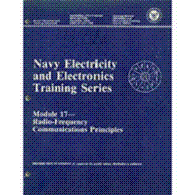Cavity Resonators
Cavity Resonators as Waveguides
In ordinary electronic equipment resonators consists of a coil and a capacitor that are connected either in series or in parallel. The resonant frequency of the circuit is increased by reducing the capacitance, the inductance, or both. A point is eventually reached where the inductance and the capacitance can be reduced no further. This is the highest frequency at which a conventional circuit can oscillate.
The upper limit for a conventional resonant circuit is between 2000 and 3000 megahertz. At these frequencies, the inductance may consist of a coil of one-half turn, and the capacitance may simply be the stray capacitance of the coil. Tuning a one-half turn coil is very difficult and tuning stray capacitance is even more difficult. In addition, such a circuit will handle only very small amounts of current.
A 1/4 wavelength section of transmission line can act as a resonant circuit. The same is true of a 1/4 wavelength section of waveguide. Since a waveguide is hollow, it can also be considered as cavity resonators .
By definition, a resonant cavity is any space completely enclosed by conducting walls that can contain oscillating electromagnetic fields and possess resonant properties. The cavity has many advantages and uses at microwave frequencies. Resonant cavities have a very high Q and can be built to handle relatively large amounts of power. Cavities with a Q value in excess of 30,000 are not uncommon. The high Q gives these devices a narrow bandpass and allows very accurate tuning. Simple, rugged construction is an additional advantage.
Although cavity resonators, built for different frequency ranges and applications, have a variety of shapes, the basic principles of operation are the same for all.
One example of a cavity resonator is the rectangular box shown in the first figure view A. It may be thought of as a section of rectangular waveguide closed at both ends by conducting plates. The frequency at which the resonant mode occurs is 1/2 wavelength of the distance between the end plates. The magnetic and electric field patterns in the rectangular cavity are shown in the next figure view B.

Rectangular waveguide cavity resonator. RESONATOR SHAPE.

Rectangular waveguide cavity resonator FIELD PATTERNS OF A SIMPLE MODE.
The rectangular cavity is only one of many cavity devices that are useful as high-frequency resonators. In the figures below view A, B, C, and D show the development of a cylindrical resonant cavity from an infinite number of quarter-wave sections of transmission line. In view A the 1/4 wavelength section is shown to be equivalent to a resonant circuit with a very small amount of inductance and capacitance.
Three 1/4 wavelength sections are joined in parallel in view B. Note that although the current-carrying ability of several 1/4 wavelength sections is greater than that of any one section, the resonant frequency is unchanged. This occurs because the addition of inductance in parallel lowers the total inductance, but the addition of capacitance in parallel increases the total capacitance by the same proportion. Thus, the resonant frequency remains the same as it was for one section. The increase in the number of current paths also decreases the total resistance and increases the Q of the resonant circuit.
Figure view C shows an intermediate step in the development of the cavity. View D shows a completed cylindrical resonant cavity with a diameter of 1/2 wavelength at the resonant frequency.

Development of a cylindrical resonant cavity. QUARTER-WAVE SECTION EQUIVALENT TO LC CIRCUIT.

Development of a cylindrical resonant cavity. QUARTER-WAVE LINES JOINED.

Development of a cylindrical resonant cavity. CYLINDRICAL RESONANT CAVITY BEING FORMED FROM QUARTER-WAVE SECTIONS.

There are two variables that determine the primary frequency of any resonant cavity. The first variable is PHYSICAL SIZE. In general, the smaller the cavity, the higher its resonant frequency. The second controlling factor is the SHAPE of the cavity. The figure below illustrates several cavity shapes that are commonly used. Remember from the previously stated definition of a resonant cavity that any completely enclosed conductive surface, regardless of its shape, can act as a cavity resonator.

Several types of cavities.
Cavity resonators are energized in basically the same manner as waveguides and have a similar field distribution. If the cavity shown in the next figure were energized in the TE mode, the electromagnetic wave would reflect back and forth along the Z axis and form standing waves. These standing waves would form a field configuration within the cavity that would have to satisfy the same boundary conditions as those in a waveguide.
Modes of operation in the cavity are described in terms of the fields that exist in the X, Y, and Z dimensions. Three subscripts are used; the first subscript indicates the number of 1/2 wavelength along the X axis; the second subscript indicates the number of 1/2 wavelength along the Y axis; and the third subscript indicates the number of 1/2 wavelength along the Z axis.

Rectangular cavity resonator.
Energy can be inserted or removed from a cavity by the same methods that are used to couple energy into and out of waveguides. The operating principles of probes, loops, and slots are the same whether used in a cavity or a waveguide. Therefore, any of the three methods can be used with cavities to inject or remove energy.
The resonant frequency of a cavity can be varied by changing any of three parameters: cavity volume, cavity capacitance, or cavity inductance. Changing the frequencies of a cavity is known as TUNING. The mechanical methods of tuning a cavity may vary with the application, but all methods use the same electrical principles.
A mechanical method of tuning a cavity by changing the volume (VOLUME TUNING) is illustrated in the figure below. Varying the distance d will result in a new resonant frequency because the inductance and the capacitance of the cavity are changed by different amounts. If the volume is decreased, the resonant frequency will be higher. The resonant frequency will be lower if the volume of the cavity is made larger.

Cavity tuning by volume.
CAPACITIVE TUNING of a cavity is shown in the next figure view A below. An adjustable slug or screw is placed in the area of maximum E lines. The distance d represents the distance between two capacitor plates. As the slug is moved in, the distance between the two plates becomes smaller and the capacitance increases. The increase in capacitance causes a decrease in the resonant frequency. As the slug is moved out, the resonant frequency of the cavity increases.

Methods of changing the resonant frequency of a cavity. CHANGING THE CAPACITANCE.

Methods of changing the resonant frequency of a cavity. CHANGING THE INDUCTANCE.
INDUCTIVE TUNING is accomplished by placing a nonmagnetic slug in the area of maximum H lines, as shown in the figure above view B. The changing H lines induce a current in the slug that sets up an opposing H field. The opposing field reduces the total H field in the cavity, and therefore reduces the total inductance. Reducing the inductance, by moving the slug in, raises the resonant frequency. Increasing the inductance, by moving the slug out, lowers the resonant frequency.
Resonant cavities are widely used in the microwave range. For example, most microwave tubes and transmitting devices use cavities in some form to generate microwave energy. Cavities are also used to determine the frequency of the energy traveling in a waveguide, since conventional measurement devices do not work well at microwave frequencies.
(back) (top) (next) (return to waveguides page)


















